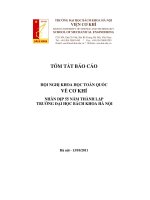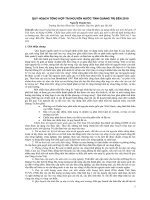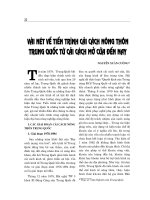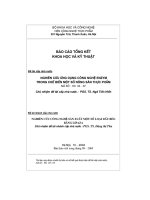Báo cáo nghiên cứu khoa học: "nghiên cứu về tình hình tăng huyết áp Tại thị xã Đông Hà, tỉnh Quảng Trị năm 2008" docx
Bạn đang xem bản rút gọn của tài liệu. Xem và tải ngay bản đầy đủ của tài liệu tại đây (127.05 KB, 10 trang )
481
JOURNAL OF SCIENCE, Hue University, N
0
61, 2010
STUDY OF THE HYPERTENSION SITUATION
AT DONGHA TOWN, QUANGTRI PROVINCE IN 2008
Le Thi Thu Trang,Tran Kim Phung
Quang Tri Health Service
SUMMARY
Hypertension has been a leading risk factor of cardiovascular disease (CDV)
and a main cause of deaths from heart complications as well. The prevalence rate of
hypertension has been increasing throughout the world over and also in Vietnam, yet no
research into this issue has ever been carried out in Quangtri. An investigation named "A Study
of the hypertension situation at Dongha town, Quangtri in 2008" was conducted
accordingly.The study aimed to investigate the rate of hypertension in Dongha, Quangtri and
explore the relationship between hypertension and several CVD risk factors in Dongha,
Quangtri. Study design: A cross-sectional investigation and analysis. Subjects: 461 men and
women aged ≥ 25 years residing at Dongha, Quang Tri. Methods: All enrolled participants
underwent measurements of height, weight, waist and BMI calculation, blood pressure, and
were quantitatively tested for a fasting venous blood glucose in the morning, and lipid
components. Evaluations were based on criteria issued by the WHO, NCEP ATPIII and the
Vietnam national heart association. Results: The hypertension rate was 26.68% and increased
with age, the age groups of 25-34, 35-44, 45-54, 55-64 and ≥ 65 accounted for 7.5%, 15.6%,
30.3%, 38.4% and
42.5% respectively. Risk factors related to hypertension included:
overweight (OR = 2.19), android obesity (OR = 2.34), dyslipidemia of at least one lipid
component (OR = 2.19), hypercholesterolemia (OR = 2.53), elevated plasma LDL-C (OR =
2.15), and hypertriglyceridemia (OR = 2.25). Diabetes mellitus, fasting glucose intolerance
(FGI), and general raised blood glucose (BG) were all evidently correlated to hypertension. The
rate of hypertension in those who had elevated levels of BG (with BG ≥ 6.1mmol/l) was 41/107
= 38.3%, those who were diabetic being 23/56 = 41%, and those who suffered from FGI being
18/41 = 35.3%. Conclusions: the high rate of hypertension was similar to other regions
throughout the country, and the rate obviously increased with age, overweight, android obesity,
metabolic dyslipidemia, hyperglycemia, and diabetes.
1. Introduction
Cardiovascular disease (CVD) is the cause of one third of all deaths in the
world,and increasingly poses a health burden on the population. Hypertension (HT) has
been a leading risk factor of CVD and a main cause of deaths from heart complications
482
such as stroke, myocardial infarction, heart failure, and renal failure. While lifespans,
overweight and obesity have been increasing and socio-psychological events have
begun to have stronger effects on people's lives, the prevalence rate of HT continued to
rise in the population. Moreover, although risk factors of uncontrolled HT were
identified, HT itself was insufficiently managed and treated in almost all patients, thus
giving rise to the high rate of cardiovascular events in the majority of treated or
untreated hypertensive persons.
In Vietnam, the prevalence rate of HT was 27.2% in 2008, and understanding
and management of HT were to a certain extent restricted. In our home province
Quangtri, no investigation on HT has been carried out so far.
Objectives of the study are to investigate the rate of hypertension in the
population of Dongha, Quangtri and reveal the relationship between hypertension and
several risk factors of CVD at Dongha, Quangtri.
2. Methods
2.1. Subjects: 461 men and women aging ≥ 25 years and residing at Dongha,
Quangtri
2.2. Methods
Design: cross-sectional investigation and analysis, simple random sampling.
Diagnosis and classification of HT according to JNC VI. All enrolled participants
underwent measurements of height, weight, waist and body mass index(BMI)
calculation, and were quantitatively tested for morning fasting venous blood glucose,
and lipid components. Evaluations were based on criteria issued by WHO, NCEP
ATPIII, WPRO and the Vietnam national heart association.
Collected data were statistically analysed.
3. Results
3.1. Rate of hypertension
Table 1. General rate of Hypertension in Dongha to compare with other region and country
Places n HT Percentage
p
Dongha, Quangtri,Vietnam (2008) 461 123 26.68
Khanhhoa, Vietnam (2004) [1] 856 204 23.83 > 0.05
Vietnam (2008) [5] 9797 2661 27.2 > 0.05
Prevalence rate of HT at Dongha was similar to other regions in Vietnam.
483
Table 2. Hypertension classification
Blood pressure (mm Hg) Dongha Vietnam p
Normal: < 130/< 85
278/461
(60.3%)
6244/9797
(63.73%)
> 0.05
High normal: 130-139/85-89
60/461
(13%)
1260/9797
(12.9%)
> 0.05
HT
Stage 1: 140-159/90-99
69/461
(14.97%)
1346/9797
(13.8%)
> 0.05
Stage 2: 160-179/100-
109
40/461
(8.68%)
555/9797
(5.7%)
< 0.005
Stage 3: 180/ 110
14/461
(3.04%)
325/9797
(3.3%)
> 0.05
Total
461
(100%)
9797
(100%)
Rates of HT in stages were the same as other places in Vietnam.
3.2. Relationship between HT and other cardiovascular risk factors
3.2.1. Relationship between HT and anthropometric risk factors
Table 3. Gender
Male Female p
Normal
n 116 160
< 0,05
Percentage (%) 55.24 63.75
High normal
N 30 32
> 0,05
Percentage (%) 14.29 12.75
HT
Stage 1
n 35 34
> 0,05
Percentage (%)
16.67 13.35
Stage 2
N 23 17
> 0,05
Percentage (%)
10.95 6.77
Stage 3
N 6 8
> 0,05
Percentage (%)
2.86 3.19
484
Subtotal
N 64 59
< 0,05
Percentage (%)
30.5 23.5
Total 210 251
HT was significantly higher in men than in women (30.5% vs. 23.5%)
Table 4. Aging groups
Age
groups
(year)
n %
Normal
BP
High
normal
BP
HT
Stage 1 Stage 2
Stage 3
Subtotal
25-34 93 20,2
78
(83.9%)
8 (8.6%) 6 (6.5%)
0 1 7 (7.5%)
35-44 90 19,5
67
(74.4%)
9 (10%)
12
(13.3%)
1 1
14
(15.6%)
45-54 99 21,5
59
(59.6%)
10
(10.1%)
16
(16.1%)
11
(11.1%)
3
30
(30.3%)
55-64 99 21,5
46
(46.5%)
16
(16.2%)
19
(19.2%)
14
(14.1%)
5
38
(38.4%)
65 80 17,4
28
(35%)
17 (21%) 16 (20%)
14
(17.5%)
4
34
(42.5%)
Total 461 100%
278
(60.3%)
60
(13%)
69 (15%)
40
(8.7%)
14 (3%)
OR(95%CI)
Dongha 1.82 (1.48-2.23)
Vietnam 1.39 (1.176-1.592)
p
Dongha <0.001
Vietnam <0.001
Rates of HT and severe HT both increased on aging.
Table 5. Body mass index (BMI)
BMI HT (n) Normal BP (n) Total
< 23 67 277 344
23 56 61 117
Total 123 338 461
485
2
35.96
OR (95%CI)
Dongha 3.8 (2.45-5.87)
Vietnam 1.82 (1.656-1.988)
p
Dongha < 0.001
Vietnam 0,001
Overweight (BMI
23) was significantly associated with HT.
Table 6. Android obesity
HT Normal BP Total
Android obesity 39 56 95
Normal 84 282 366
Total 123 338 461
2
12.63
OR (95%CI) 2.34 (1.46-3.37)
P < 0.001
Android obesity was significantly associated with HT.
3.2.2. Relationship between HT and dyslipidemia
Table 7. At least one abnormal lipid component
HT Normal BP Total
Yes 103 237 340
No 20 101 121
Total 123 338 461
2
8,64
OR (95%CI)
Dongha 2.19 (1.30-3.71)
Vietnam 8.31 (1.95-35.39)
P
Dongha < 0.005
Vietnam 0.004
Dyslipidemia of at least one component was significantly associated with HT.
486
Table 8. Elevated total cholesterolemia
HT Normal BP Total
Yes 58 88 146
No 65 250 315
Total 123 338 461
2
18.59
OR (95%CI)
Dongha 2.53 (1.66-3.87)
Vietnam 2.28 (1.492-3.479)
P
Dongha < 0.001
Vietnam < 0.001
Hypercholesterolemia was significantly associated with HT
Table 9. Elevated lower density lipoprotein – cholesterol(LDL-C)
HT Normal BP Total
Yes 40 62 102
No 83 276 359
Total 123 338 461
2
10.52
OR (95%CI)
Dongha 2.15 (1.35-3.4)
Vietnam 1.49 (1.145-1.936)
P
Dongha < 0.005
Vietnam 0.003
Elevated LDL-C was significantly associated with HT
Table 10. Reduced high density lipoprotein cholesterol (HDL-C)
HT Normal BP Total
Yes 56 141 179
No 67 197 246
Total 123 338 416
2
0.54
487
OR (95%CI)
Dongha 1.17 (0.77-1.77)
Vietnam 1.19 (0.663-2.235)
P
Dongha > 0.05
Vietnam 0.59
Reduced HDL-C was not a risk factor of HT.
Table 11. Elevated triglyceridemia
HT Normal BP Total
Yes 78 147 225
No 45 191 336
Total 123 338 461
2
14,33
OR (95%CI)
Dongha 2.25 (1.48-3.43)
Vietnam 1.55 (1.554-2.122)
P
Dongha < 0.001
Vietnam 0.008
Elevated triglyceridemia was significantly associated with HT
3.3. Relationship between hypertension with elevated blood glucose
Table 12. Relationships between hypertension and diabetes (DM) and fasting glucose
intolerance (FGI)
HT
DM and FGI DM FGI
Yes No Yes No Yes No
Yes 41 82 23 100 18 105
No 66 272 33 305 33 305
OR (95%CI) 2.06 (1.3÷3.25) 2.13(1.2÷3.76) 1.58 (0.68÷2.92)
p < 0.005 < 0.05 > 0.05
HT was significantly correlated with elevated blood glucose (DM and FGI) and
DM; but not with single FGI. Prevalence rates of HT in elevated blood glucose, DM
and FGI persons were respectively 38.3%, 41% and 35.3%.
488
4. Discussions
Prevalence the rate of HT in persons 25 years at Dongha (26.7%) was
relatively similar to other regions in Vietnam. Rates of stage-1, -2 and -3 HT were 15%,
8.7% and 3% respectively, and similar to those in Vietnamese people [5].
Gender: HT was significantly higher in men than in women (30.5% vs. 23.5%),
but there was no difference between the two in each stage of classification [1], [5].
Age: The rate of HT increased on aging, and age groups of 25-34, 35-44, 45-54,
55-64 and 65 respectively accounted for 7.5%, 15.6%, 30.3%, 38.4% and 42.5%.
These figures were relatively similar to those in Pham Gia Khai's and Phan Long Nhon's
(Binh Dinh) studies [5]. The rate of severe HT, likewise, increased with age (stage-1
HT was primarily seen in those < 45 years, while stage-2 HT in those > 45 years). The
rate of HT was considerably high in working age groups. Especially in the still very
young age group of 25-34, the rates of HT mounted up to 7.5%, not including 8.6% of
which had high normal BP- which may cause injuries to target organs and progress to
real HT.
BMI: Overweight (BMI 23) was significantly associated with HT (OR = 3.8,
95%CI = 2.45-5.87).
Android obesity: Android obesity was also significantly associated with HT.
The rate of HT in those with android obesity was 39/95 = 41.05%, while in those
without android obesity 84/366 = 22.95%.
Sanjay Vikrant proved in his study [10] that HT was more likely detected in
obese persons than in people with normal BMI, and the higher the BMI, the higher the
rate of HT.
Dyslipidemia: Dyslipidemia was significantly associated with HT. The rate of
HT in those with dyslipidemia of at least one component was 30%, while in others with
normal lipid levels 16.5%.
The rate of HT in those with hypercholesterolemia was 58/146 = 39.7%, while
in the others with normal cholesterolemia it was 65/315 = 20.6%. Kaplan M.N.
suggested that cholesterolemia was often elevated in hypertensive persons, for
hypercholesterolemia evidently injures the intima-dependent vasodilatory mechanism
[7].
Rates of HT in those with and without elevated LDL-C were 40/102 = 39.2%
and 83/359 = 23.1%, respectively.
Reduced HDL-C was not a risk factor of HT. Rates of HT in those with and
without reduced HDL-C were approximately the same (31.3% vs. 27.2%, respectively).
Rates of HT in groups with hypertriglyceridemia and with normal
489
triglyceridemia were 78//225 = 34.7% and 45/336 = 13.4% respectively.
Diabetes mellitus and fasting glucose intolerance: Fasting blood glucose
levels 6.1mmol/l were significantly associated with HT. The rate of HT in those with
fasting blood glucose levels 6.1mmol/l was 41/107 = 38.3%, in diabetics being 23/56
= 41%, in those with FGI being 18/41 = 35.3%. Sanjay Vikrant [10] and Kaplan M.N.
[7] supposed that insulin resistance and elevated blood glucose were related to HT. The
NHANES III study reported 71% of diabetics had HT [7].
5. Conclusions
5.1. Rate of HT was 26.68%.
5.2. Rates of HT in age groups of 25-34, 35-44, 45-54, 55-64 and 65
respectively accounted for 7.5%, 15.6%, 30.3%, 38.4% and 42.5%.
5.3. Risk factors associated with HT: Overweight (OR=3.8, 95%CI = 2.45-5.87,
p<0.001), android obesity (OR = 2.34, 95%CI=1.46-3.37, p < 0.001), Dyslipidemia of
at least one component (OR = 2.19, 95%CI= 1.3-3.71, p < 0.005), hypercholesterolemia
(OR = 2.53 95%CI = 1.66-3.87, p < 0,001), elevated LDL-C (OR = 2.15, 95%CI
=1.35-3.4, p < 0.005) and hypertriglyceridemia (OR = 2.25, 95%CI = 1.48-3.43, p <
0.001).
5.4. DM, elevated blood glucose of 6.1 mmol/l were obviously associated with
HT and rates of HT in these two circumstances were 41% and 38.3%, respectively.
REFERENCES
1. Tran Van Huy, Truong Tan Minh (2004), Epidemiology of main cardiovascular
risk factors in adults in Khanh Hoa province, Journal of Vietnam Cardiology, No.
37/2004, 580-596.
2. Huynh Van Minh, Pham Gia Khai, Nguyen Huy Dung, ,(2008), Vietnam heart
association recommendation on diagnosis, treatment and prevention of
hypertension in adults, Recommendations on cardiovascular and metabolic
diseases, 235-294.
3. Huynh Van Minh, Đoan Phuoc Thuoc, , (2008), Epidemiological features of
metabolic syndrome in the Thua Thien-Hue population and in high risk subjects,
Practical medicine, No. 616-617, 594-609.
4. Phan Long Nhon (2007), Study on hypertension situation in adults in northern
Binh Dinh province, Journal of Vietnam Cardiology, No. 47, Aug 2007, 31-38.
5. Pham Gia Khai (2008), Epidemiology of hypertension in Vietnam, Reported at
17
th
ASEAN cardiology conference.
490
6. Burt VL, Whelton P, Roccella EJ, , (1995) Prevalence of hypertension in the
US adult population. Results from the third National Health and Nutrition
Examination Survey, Hypertension, 1995 mar:25(3):305-13.
7. Kaplan MN, System Hypertension: Mechanism and diagnosis, Heart disease -
chapter 37, 2005.
8. Lip G.Y.H, Hall J.E, Comprehensive Hypertension, Mosby Elsevier, (2007).
9. The Joint National Committee, The seventh report of the Joint National
Committee on Prevention, Detection, Evaluation, and Treatment of high blood
pressure, (2004).
10. Vikrant S, Tiwari SC, Essential Hypertension - pathogenesis and
pathophysiology, Journal, Indian Academy of Clinical Medicine vol.2, No.3:
2001, 140-161.









